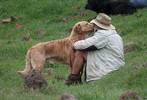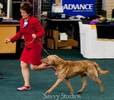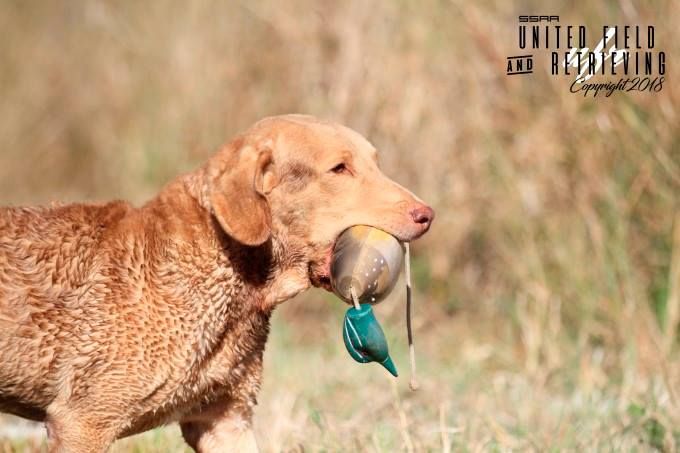THE BREED
Last Updated: 21 November 2022
[Print A4 PDF of Breed Standard] [print page]

American Kennel Club, effective from 31/12/1993
FCI Standard No. 263
Adopted in Australia 01/07/2010
Country of Origin: United States of America
| Group: |
Group 3 (Gundogs) |
| History: |
|
| General Appearance: |
Equally proficient on land and in the water, the Chesapeake Bay Retriever was developed along the Chesapeake Bay to hunt waterfowl under the most adverse weather and water conditions, often having to break ice during the course of many strenuous multiple retrieves. Frequently the Chesapeake must face wind, tide and long cold swims in its work. The breed's characteristics are specifically suited to enable the Chesapeake to function with ease, efficiency and endurance. In head, the Chesapeake's skull is broad and round with a medium stop. The jaws should be of sufficient length and strength to carry large game birds with an easy, tender hold. The double coat consists of a short, harsh, wavy outer coat and a dense, fine, woolly undercoat containing an abundance of natural oil and is ideally suited for the icy rugged conditions of weather the Chesapeake often works in. In body, the Chesapeake is a strong, well-balanced, powerfully built animal of moderate size and medium length in body and leg, deep and wide in chest, the shoulders built with full liberty of movement, and with no tendency to weakness in any feature, particularly the rear. The power though, should not be at the expense of agility or stamina. Size and substance should not be excessive as this is a working retriever of an active nature.
Distinctive features include eyes that are very clear, of yellowish or amber hue, hindquarters as high or a trifle higher than the shoulders, and a double coat which tends to wave on shoulders, neck, back and loins only.
The Chesapeake is valued for its bright and happy disposition, intelligence, quiet good sense, and affectionate protective nature. Extreme shyness or extreme aggressive tendencies are not desirable in the breed either as a gun dog or companion.
Disqualifications: Specimens that are lacking in breed characteristics should be disqualified.
Important Proportion:
Height to Length Ratio: Height from the top of the shoulder blades to the ground should be slightly less than the body length from the breastbone to the point of buttocks.
Depth of Body: Depth of body should extend at least to the elbow.
Balance of Withes to Elbow and Elbow to Ground: Shoulder to elbow and elbow to ground should be equal.
Approximate Measurements Inches Centimetres
Length head, nose to occiput 9½ to 10 24.13 to 25.40
Girth at ears 20 to 21 50.80 to 53.34
Muzzle below eyes 10 to 10½ 25.40 to 26.67
Length of ears 4½ to 5 11.43 to 12.70
Width between eyes 2½ to 2¾ 6.35 to 6.99
Girth neck close to shoulder 20 to 22 50.80 to 55.88
Girth at flank 24 to 25 60.96 to 63.50
Length from occiput to tail base 34. to 35 86.36 to 88.90
Girth forearms at shoulders 10 to 10½ 25.40 to 26.67
Girth upper thigh 19 to 20 48.26 to 50.80
From root to root of ear, over skull 5 to 6 12.70 to 15.24
Occiput to top shoulder blades 9 to 9½ 22.86 to 24.13
From elbow to elbow over the 25 to 26 63.50 to 66.04
shoulders |
| Characteristics: |
Not detailed under this heading. |
| Temperament: |
The Chesapeake Bay Retriever should show a bright and happy disposition with an intelligent expression. Courage, willingness to work, alertness, nose, intelligence, love of water, general quality and, most of all, disposition should be given primary consideration in the selection and breeding of the Chesapeake Bay Retriever. |
| Head And Skull: |
The Chesapeake Bay Retriever should have an intelligent expression.
Skull is broad and round with a medium stop.
Muzzle is approximately the same length, as the skull, tapered, pointed but not sharp.
Nose is medium short
Lips are thin, not pendulous.
|
| Eyes: |
Eyes are to be medium large, very clear, of yellowish or amber colour and wide apart. |
| Ears: |
Ears are to be small, set well up on the head, hanging loosely, and of medium leather. |
| Mouth: |
Bite: Scissors is preferred, but a level bite is acceptable.
Disqualifications: Either undershot or overshot bites are to be disqualified.
|
| Neck: |
Neck should be of medium length with a strong muscular appearance, tapering to the shoulders. |
| Forequarters: |
There should be no tendency to weakness in the forequarters.
Shoulders should be sloping with full liberty of action, plenty of power and without any restrictions of movement.
Legs should be medium in length and straight, showing good bone and muscle. Pasterns slightly bent and of medium length.
The front legs should appear straight when viewed from front or rear. Dewclaws on the forelegs may be removed.
|
| Body: |
Body is of medium length, neither cobby nor roached, but rather approaching hollowness from underneath as the flanks should be well tucked up.
Topline should show the hindquarters to be as high as or a trifle higher than the shoulders.
Back should be short, well coupled and powerful.
Chest should be strong, deep and wide. Rib cage barrel round and deep
|
| Hindquarters: |
Good hindquarters are essential. They should show fully as much power as the forequarters. There should be no tendency to weakness in the hindquarters. Hindquarters should be especially powerful to supply the driving power for swimming.
Legs should be medium length and straight, showing good bone and muscle.
Stifles should be well angulated.
The distance from hock to ground should be of medium length. The hind legs should look straight when viewed from the front or rear. Dewclaws, if any, must be removed from the hind legs.
Disqualifications: Dewclaws on the hind legs are a disqualification.
|
| Feet: |
Well webbed hare feet should be of good size with toes well-rounded and close. |
| Tail: |
Tail of medium length; medium heavy at the base. The tail should be straight or slightly curved and should not curl over back or side kink. |
| Gait/Movement: |
The gait should be smooth, free and effortless, giving the impression of great power and strength. When viewed from the side, there should be good reach with no restrictions of movement in the front and plenty of drive in the rear, with good flexion of the stifle and hock joints. Coming at you, there should be no sign of elbows being out. When the Chesapeake is moving away from you, there should be no sign of cowhockness from the rear. As speed increases, the feet tend to converge toward a centre line of gravity.
|
| Coat: |
Coat should be thick and short, nowhere over 1½ inches long, with a dense fine woolly undercoat. Hair on the face and legs should be very short and straight with a tendency to wave on the shoulders, neck, back and loins only. Moderate feathering on rear of hindquarters and tail is permissible. The texture of the Chesapeake's coat is very important, as the Chesapeake is used for hunting under all sorts of adverse weather conditions, often working in ice and snow. The oil in the harsh outer coat and woolly undercoat is of extreme value in preventing the cold water from reaching the Chesapeake's skin and aids in quick drying. A Chesapeake's coat should resist the water in the same way that a duck's feathers do. When the Chesapeake leaves the water and shakes, the coat should not hold water at all, being merely moist.
Disqualifications: A coat that is curly or has a tendency to curl all over the body must be disqualified. Feathering on the tail or legs over 1¾ inches long must be disqualified.
|
| Colour: |
The colour of the Chesapeake Bay Retriever must be as nearly that of its working surroundings as possible. Any colour of brown, sedge or deadgrass is acceptable, self-coloured Chesapeakes being preferred. One colour is not to be preferred over another. A white spot on the breast, belly, toes, or back of the feet (immediately above the large pad) is permissible, but the smaller the spot the better, solid coloured preferred. The colour of the coat and its texture must be given every consideration when judging on the bench or in the ring. Honourable scars are not to be penalized.
Disqualifications: Black coloured; white on any part of the body except breast, belly, toes, or back of feet must be disqualified.
|
| Sizes: |
Proportion, Substance
Height--Males should measure 58.42 to 66.04 centimetres (23 to 26 inches); females should measure 53.34 to 60.96 centimetres (21 to 24 inches).
Oversized or undersized animals are to be severely penalized.
Weight--Males should weigh 29.51 to 36.32 Kilograms (65 to 80 lbs); females should weigh 24.97 to 31.78 Kilograms (55 to 70 lbs).
|
| Faults: |
Any departure from the foregoing points should be considered a fault and the seriousness with which the fault should be regarded should be in exact proportion to its degree and its effect upon the health and welfare of the dog, and on the dog’s ability to perform its traditional work.
Disqualifications:
1. Specimens lacking in breed characteristics.
2. Teeth overshot or undershot.
3. Dewclaws on the hind legs.
4. Coat curly or with a tendency to curl all over the body.
5. Feathering on the tail or legs over 1¾ inches long.
6. Black coloured.
7. White on any part of the body except breast, belly, toes, or back of feet.
The question of coat and general type of balance takes precedence over any scoring table, which could be drawn up. The Chesapeake should be well proportioned, an animal with a good coat and well balanced in other points being preferable to one excelling in some but weak in others.
Positive Scale of Points (Should be only used for a reference and not used for judging)
Head, including lips, ears and eyes 16
Neck 4
Shoulders and body 12
Hindquarters and stifles 12
Elbows, legs and feet 12
Colour 4
Stern and tail 10
Coat and texture 18
General conformation 12
Total 100
|
| Notes: |
Male animals should have two apparently normal testicles fully descended into the scrotum. |
| Last Updated: 25 May 2009 |
Chesapeake Bay Retriever: General Information
BACKGROUND
In 1807, an English ship was wrecked off the coast of Maryland and the survivors included two puppies, a red male named Sailor and a black bitch named Canton. The puppies were of the St John's Newfoundland breed that was used to help fishermen retrieve their nets. The local waterfowl hunters used these pups and their offspring soon became known for their courage and prowess in the icy cold waters of the Chesapeake Bay. The original pups were crossed with other breeds in this area including water spaniels, curly and flat-coated retrievers, pointers, setters, and coonhounds. Always the selection of breeding stock was based entirely on superior working ability.
The strength and endurance of the Chesapeake Bay Retriever with its incredible courage, enabled these dogs to make long swims and to retrieve more than 200 ducks or geese in a single day. The breed gained the reputation of an incomparable water-retrieving dog in snow, ice, and heavy seas as cold water does not bother them
AVERAGE LIFESPAN
The Chesapeake Bay Retriever can live up to 12 years of age.
BREED PERSONALITY, CHARACTERISTICS & TEMPERAMENT
The Chesapeake Bay Retriever is a multi-purpose dog, a marvellous companion, and an individualist who possesses independence and loyalty with a certain aloofness. The Chesapeake is a one-family dog with a very strong protective nature for what belongs to them or their adopted family. The breed has a strong affinity for children and is very protective of them.
They are regarded as an intelligent breed with a bright and happy disposition. As a retriever, they have a remarkable memory for multiple retrieves and very good marking ability. The memory is very apparent when Chesapeakes are used for other activities such as obedience, as they are very trainable.
COMPATIBILITY WITH OTHER PETS
Once a Chesapeake Bay Retriever becomes a member of a family, the dog accepts all members of that family whether they are human or animal. A well-socialized pup will readily accept any other pets as part of its kingdom, but it does tend to want to be "top dog".
CARE REQUIREMENTS
The Chesapeake Bay Retriever is a low-maintenance breed. A brushing once a week is adequate to remove loose hair from the coat which is assisted if the dog can swim at least once a week. In full coat, the Chessie should not be bathed with soap or detergent as this will remove the natural protective oil. This oil renders the dog almost waterproof. Incidences of grass or flea allergies, hot spots, or other skin problems rarely occur in this breed. Adults do not require a lot of exercise, but it is important for growing pups. With their great love of water, Chessies should be able to swim as often as possible.
Please take note:
The strong protective nature of this breed for its family can be mistaken for aggressiveness and as such it is important to socialise the pup with other animals and people at an early age, particularly male pups. Once a Chesapeake Bay Retriever understands the ground rules, there are unlikely to be any future problems but it is important to teach these ground rules at an early age as an adult Chessie is a big, powerful dog.
The breed may have two inherited genetic diseases Hip Dysplasia and Progressive Retinal Atrophy that have been identified overseas. Fortunately, the breed is relatively recent to Australia and all breeding stock imported from America and the United Kingdom have been tested free of both diseases. Subsequently, these problems have rarely occurred in Australia.
IDEAL OWNERS
Any person who can ensure that the Chesapeake Bay Retriever will be able to share their life and can train and control a dog is a suitable owner. Ideally, the person would lead an active outdoor life and be able to reciprocate the Chessie's love and affection. The breed makes a great children's companion and will play for hours.
IN CONCLUSION
If you have decided that the Chesapeake Bay Retriever is the dog for you and you are prepared to take it for swims during the summer, we look forward to hearing from you.
DECISION TIME
Before deciding on getting a puppy, here are points to consider:
CANINE CLUBS
Australian Capital Territory
ACT Canine Association Inc
PO Box 815
Dickson, ACT 2602
Tel: 02 6241 4404
Fax: 02 6241 1129
Website: www.actca.asn.au
|
|
New South Wales
Dogs NSW
PO Box 632
St Marys, NSW 1790
Tel: 02 9834 3022 or 1300 728 022 (NSW only)
Fax: 02 9834 3872
Website: www.dogsnsw.org.au
|
Northern Territory
The North Australian Canine Association Inc
PO Box 37521
Winnellie, NT 0821
Tel: 08 8984 3570
Fax: 08 8984 3409
Website: www.users.bigpond.com/naca1/
|
|
Queensland
Dogs QLD
PO Box 1136
Mt Ommaney, Qld 4074
Tel: 07 3252 2661
Fax: 07 3252 3864
Website: www.cccq.org.au
|
South Australia
South Australian Canine Association Inc
PO Box 844
Prospect East, SA 5082
Tel: 08 8349 4797
Fax: 08 8262 5751
Website: www.saca.caninenet.com
|
|
Tasmania
Tasmanian Canine Association Inc
The Rothman Building
PO Box 116
Glenorchy, Tas 7010
Tel: 03 6272 9443
Fax: 03 6273 0844
Website: www.tca.freeservers.com
|
Victoria
Victorian Canine Association
Locked Bag K9
Cranbourne, Vic 3977
Tel: 03 9788 2500
Fax: 03 9788 2599
Website: www.vca.org.au
|
|
Western Australia
Canine Association of Western Australia Inc
PO Box 1404
Canning Vale, WA 6970
Tel: 08 9455 1188
Fax: 08 9455 1190
Website: www.cawa.asn.au
|
|
|



